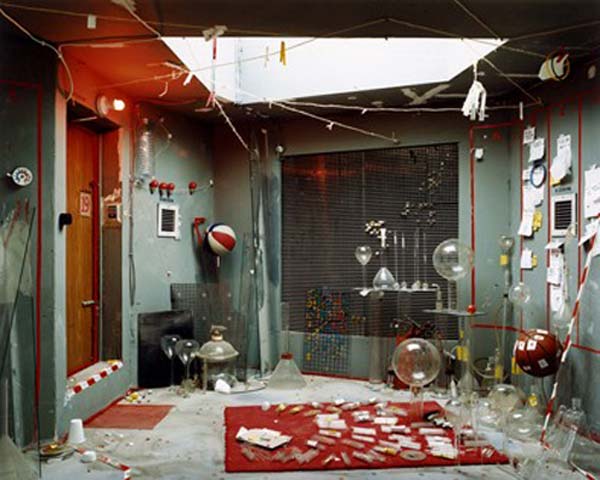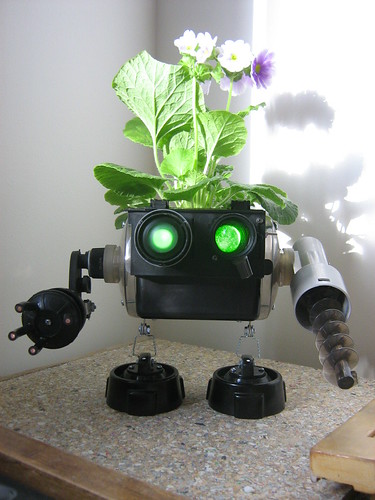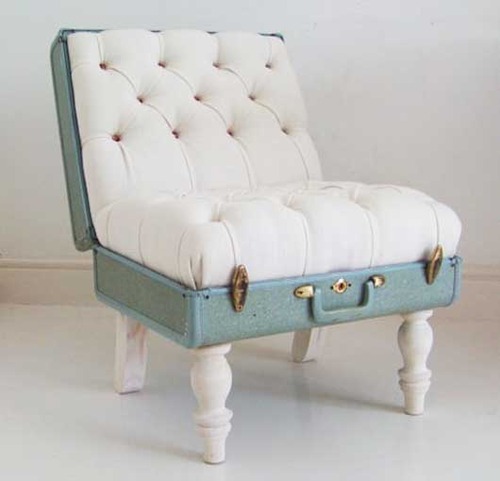Concept: the lack of a recession for the second hand market and the availability of hand-me-down products
ANNE HARDY
Hardy’s work is constructed within empty spaces, repopulated with sourced second hand furnishings and objects that reanimate the ‘room’ into discombobulated, dystopian environments. The lack of displayed human interaction leaves us to create how the rooms came to be how they appear, rendering their disorientating appearance ‘dreamscapes’. Her images appear painterly, as they are constructed to be viewed purely from the camera’s vantage point, producing a purely two-dimensional environment. The images will always appear unreal or fabricated, yet the scenes depicted still ‘possess’ the space.
In looking at her work, the concept of using an object from someone else’s life to create a new pictorial one springs to mind. Second hand objects carry with them a story of their past ‘life’ and in creating new images with them it carries on both their legacy and their function. Reusing furniture reduces waste that has been created by fly-tippers, but can be used to a similar visual effect, as if they have been dropped into the scenes.
 |
| Detatched, 2009 |
 |
| Cell, 2004 |
 |
| Untitled VI, 2005 |
MARIO CAICEDO LANGER
Langer works with broken gadgets, scrap metal and other unwanted waste to create a series of cyborg-style sculptural creations. He reuses a common waste product due to the vast increase in electrical consumerism and consumption in the past thirty years. The forms he creates take items that would otherwise take a lot of energy to melt down into bi-products and reform, and creates new products that can be reused in their reincarnations.
Langer works with broken gadgets, scrap metal and other unwanted waste to create a series of cyborg-style sculptural creations. He reuses a common waste product due to the vast increase in electrical consumerism and consumption in the past thirty years. The forms he creates take items that would otherwise take a lot of energy to melt down into bi-products and reform, and creates new products that can be reused in their reincarnations.
Langer’s art inspires ideas of using found, ‘unneeded’ or refused objects to create something functional once more, such as ornaments as he did, or other items such as furniture.
 |
| Tin Man, 2009 |
 |
| Robo-Planter, 2011 |
MATT WAIN
I came across this commercial photographer when researching photographers who shoot portraits of people in their personal environments. I was drawn to using his work as an example in this research as in these shots the use of the environment expresses the idea that people have a relationship with furniture and visa versa. This made me think about the change that occurs to cast-off or second hand furniture that is bought or collected; does it lose its story/surface memory when passed from one person to another, and how does it reincorporate itself into a new environment.
Obviously the furniture in his images doesn’t suggest they are second hand but it is relevant to the portraiture theme of the project to see the relationship between subject and environment. From this I personally would be inspired to photograph the homes of those who collect second hand furniture but, unlike the work of Anne Hardy, I would have the subject in the image to draw parallels between the furniture and the owner, suggesting the personal relationship between them.
KATIE THOMPSON
Thompson is a South African designer who fashions furniture from recycled objects, such as old suitcases, buckets and umbrellas. The pieces she creates have a vintage finish to them, showing that recycled goods can seem upmarket and need a second glance to notice why they have a quirky edge to them, rather than old rusty objects cluttering up gutters. The concept of recycling objects before they decompose or lay waste in a rubbish dump is a fast growing concept and many boutiques offer these kinds of products.
My research has inspired me to come up with an idea to collect objects from people I know and from fly tipping that are no longer wanted or needed to craft a new environment in a studio. Although overly ambitious, this is what my visual concept would start out as:
I would use these objects to reconstruct either a 360˚/270˚ scene of a room, or multiple single vantage point scenes of a room, and photograph various parts of the scene to create various narratives about the suggested inhabitant of the scene. I would construct furniture in the style of Katie Thompson, by using bits of furniture and other objects. I would be tempted to pastiche the dystopian backdrops of Anne Hardy’s work and also her use of hanging objects to fill the room so that no part of the image(s) is empty.
If I were to create just one scene, I would shoot it from various angles with a shallow depth of field focusing on the key item in each image, which I would intend on basing a story around.
If three separate scenes were created, I would shoot with a large depth of field to emphasise the sheer amount of objects, as I would aim to cram a lot into one area, creating jumble heaps, much like scenes in the movie Labyrinth in the junk yard where children’s forgotten things end up.
I would light it with the studio’s own continuous overhead tungsten lighting and use a softbox flash, to recreate interior lighting and a natural light source like a window to highlight some objects, possibly coming through a fake window.





No comments:
Post a Comment